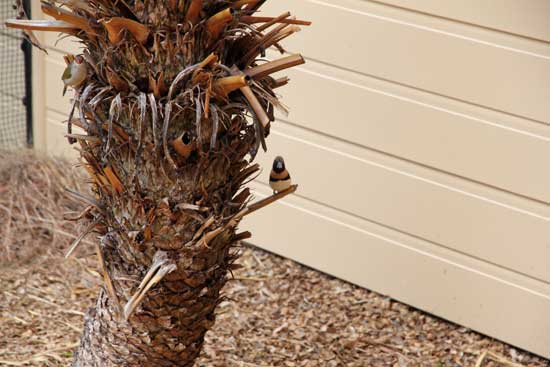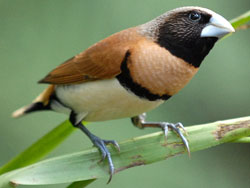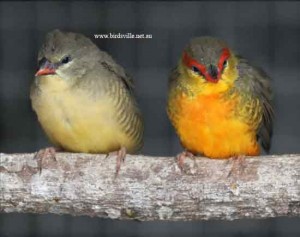Chestnut Breasted Mannikin
Lonchura castaneothoraxDistribution and Habitat of chestnut breasted mannikin’s
Chestnut Breasted Manikins are found in Northern and Eastern Coastal Australia. These birds can be found in small parties and pairs. I have seen them in flocks of up to 300 individual birds north of Cairns. They are often found in low land areas with tall seeding grasses during the rainy season but migrate in land during the dry season.
In the wild these birds often nest in tall grasses and occasionally shrubs, as they once used to do in my back yard when I lived in Port Douglas in north Queensland.
Licencing
To purchase these birds from Birdsville you must have a licence from National Parks and wildlife Service (NPWS).
Diet for chestnut breasted mannikin finches
Seed- Like all birds diet is key to not only the internal health but also their coloration. A good quality seed mix is essential to breeding chestnut breasted mannikins. Be wary of many supermarket mixes as despite having fancy packaging are a very poor quality mix. If you are unsure of the seed mix you are purchasing ask your local bird expert or breeders. This is important as diet has everything to do with the long jevity and breeding success with all finches. Some extra seed may be offered in the form of rape seed, hulled oats, and linseed.
Sprouted seed– A great addition to your birds diet, make sure it is washed thoroughly with aviclens before feeding to your birds to remove bacteria.
Millet sprays– Relished by finches this is a fresh seed on the stem, french white is most recommended for finches.
Vitamin supplement– There are many great vitamin supplements for birds available in Australia, this must be supplied via the water supply to be effective as it is wasted in seed.
Greens– are essential- fresh seeding grass, broccoli, endive, flowering heads of milk thistle, chickweed, dandelion, broccoli and silver beet .
Live food– Eaten eagerly by chestnuts live food such as meal worms and fly pupae can be fed with a few pinches of wombaroo insectivore mix
Egg and biscuit formula–
Grit– is important for calcium i would recommend using fine grit that also contains limestone, Baked egg shell, Crushed cuttlebone, shell and charcoal.
fruits– such as apple, pear corn and pawpaw

Breeding chestnut breasted mannikins
I used to live just outside of port douglas in far north queensland and had these guys nesting every summer only a metre off the ground in the lilly pilly trees. They will also nest in thickets of grass as we used to have lot’s of young fledgling mannikins brought in by landscapers after they cut down the long grass and the babies fell out of the nest.
In captivity they will breed in woven wicker nest and finch nest boxes. Always supply nesting material. If you have a large aviary they will also nest in tall grass and shrubs.
The hen will lay around 6 or 7 white eggs which will take about 13 days of incubation. The young will be raised inside the nest for a further 3 to 4 weeks. when they venture outside the nest for the first time they will still be dependant of the parent birds to feed them for a further 3 to 4 weeks.
These birds breed from December until march if breeding in captivity it is important to supply them with live food such as meal worms, maggots or fly pupae (available at Birdsville). Egg and biscuit (available at Birdsville) and greens such as endive, spinach, bok choy and lebanese cucumber should be a regular part of there diet Chestnuts can have around 3 or 4 clutches a year.

Always worm your bird’s every 6 months
spray lice and mite treatment every 3 months
Treat for coccidioses every 3 months
Found in store, for more details call Birdsville 9667 2555.




